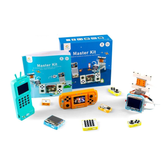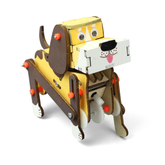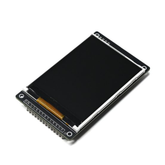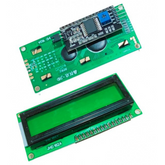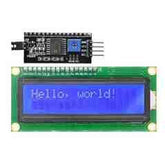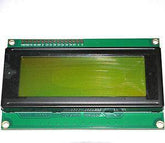-
16x2 LCD Module (Green)16x2 LCD Module (Green) This is the brand new high-quality 16x2 LCD Green Backlight. It is a simple and cost-effective way to incorporate a 16x2 White on RGB Liquid Crystal Display into your project. The LCD display module is 16 characters by 2 lines...
- Rs. 82
Rs. 149- Rs. 82
- Unit price
- per
Save Rs. 67 -
16x4 LCD Display With Green Backlight16x4 LCD Display With Green Backlight This is the 16x4 LCD Display, A display is required if you want to add visual output to your Arduino projects. If you only need a small amount of information displayed, the 16x4 LCD Display is a good choice....
- Rs. 348
Rs. 475- Rs. 348
- Unit price
- per
Save Rs. 127 -
128x64 Graphic LCD -Blue Backlight128x64 Graphic LCD -Blue Backlight The 128x64 graphic LCD display is based on the ST7920 controller, which is a popular Arduino controller. It is simple to use and works with the vast majority of microcontrollers on the market. With this Graphic LCD, you can do...
- Rs. 437
Rs. 711- Rs. 437
- Unit price
- per
Save Rs. 274 -
Original JHD 20x4 Character LCD DisplayOriginal JHD 20x4 Character LCD Display A 20x4 LCD display is a basic module that is commonly used in various devices and circuits. It is preferred over seven-segment and other multi-segment LEDs because it is economical, easily programmable, and can display special and custom...
- Rs. 329
Rs. 499- Rs. 329
- Unit price
- per
Save Rs. 170 -
SmartElex 2.8 Inch TFT LCD Display – 240x320 Color LCD Screen for DIY ElectronicsSmartElex 2.8 Inch TFT LCD Display – 240x320 Color LCD Screen for DIY Electronics The SmartElex 2.8 Inch TFT LCD Display is a vibrant and easy-to-use color screen perfect for your DIY electronics and embedded projects. With a clear 240x320 pixel resolution, it delivers...
- Rs. 757
Rs. 1,425- Rs. 757
- Unit price
- per
Save Rs. 668 -
128x64 Graphic LCD -Yellow BacklightJHD 128x64 Graphic LCD -Yellow Backlight This is the original jHD128x64 LCD display with Yellow backlight, It is simple to use and works with the vast majority of microcontrollers on the market. With this Graphic LCD, you can do a lot of graphic things. You...
- Rs. 437
Rs. 750- Rs. 437
- Unit price
- per
Save Rs. 313 -
Original JHD 20x4 character LCD Display with Blue BacklightOriginal JHD 20×4 character LCD Display with Blue Backlight This is an original JHD 20 x 4 Parallel LCD Display that provides a simple and cost-effective solution for adding a 20 x 4 white on RGB Liquid Crystal Display into your project. The display...
- Rs. 465
Rs. 644- Rs. 465
- Unit price
- per
Save Rs. 179 -
ELECROW ESP32 7In HMI Display 800×480 RGB TFT LCD Touch Screen without Acrylic CaseELECROW ESP32 7In HMI Display 800×480 RGB TFT LCD Touch Screen without Acrylic Case Elecrow 7.0" HMI Display is meticulously crafted to cater to the needs of engineers, hobbyists, developers, and makers alike, seeking an advanced touch screen solution for their diverse projects. At...
- Rs. 4,034
Rs. 5,499- Rs. 4,034
- Unit price
- per
Save Rs. 1,465 -
1.8 inch TFT LCD Module1.8 inch TFT LCD Module This is the 1.8 inch TFT LCD Module, This TFT LCD display Module communicates via 4-wire SPI and has its own pixel-addressable frame buffer; it can be used with any type of microcontroller. Even a very small one with limited memory and...
- Rs. 290
Rs. 449- Rs. 290
- Unit price
- per
Save Rs. 159 -
8X2 LCD module - Green8X2 LCD module - Green The 8x2 Green color LCD display module is the perfect solution for hobbyists and electronic enthusiasts. This versatile LCD module, capable of displaying 8 characters per line across 2 lines, is ideal for various electronic projects. The green color enhances...
- Rs. 145
Rs. 249- Rs. 145
- Unit price
- per
Save Rs. 104 -
16x2 Green LCD with Soldered I2C/IIC Interface16x2 Green LCD with Soldered I2C/IIC Interface If you need an easy-to-use display for your project, the 16x2 Green LCD with Soldered I2C/IIC Interface is a great option. It shows 16 characters across 2 lines with a clear green backlight, so you can read...
- Rs. 188
Rs. 249- Rs. 188
- Unit price
- per
Save Rs. 61 -
16x2 LCD (Blue) with I2C Interface16x2 LCD (Blue) with I2C Interface This is a great LCD module for different types of Arduino projects. If you want to display your results and see the output, the 16x2 LCD Display is the perfect component for DIY Arduino projects. The values shown on the 16x2...
- Rs. 256
Rs. 345- Rs. 256
- Unit price
- per
Save Rs. 89 -
20x4 LCD Module (Green)20x4 LCD Module (Green) This is an 20 x 4 Parallel LCD Display that provides a simple and cost-effective solution for adding a 20 x 4 Black on RGB Liquid Crystal Display into your project. The display is 20 character by 4-line display that...
- Rs. 261
Rs. 459- Rs. 261
- Unit price
- per
Save Rs. 198 -
ELECROW ESP32 HMI 2.8 Inch TFT Touch Display 240×320 SPI LCD for Arduino/LVGL/Esphome/PlatformIO/Micropython without Acrylic CaseELECROW ESP32 HMI 2.8 Inch TFT Touch Display 240×320 SPI LCD for Arduino/LVGL/Esphome/PlatformIO/Micropython without Acrylic Case Elecrow ESP32 Display-2.8 Inch HMI is a cutting-edge touch screen display designed to empower DIY enthusiasts, professionals, and developers with unparalleled functionality and versatility. At its core lies...
- Rs. 1,965
Rs. 3,344- Rs. 1,965
- Unit price
- per
Save Rs. 1,379 -
7 inch LCD Capacitive Touch Panel with HDMI and USB Cable7 inch LCD Capacitive Touch Panel with HDMI and USB Cable This 7 inch LCD Capacitive Touch Panel is not only for mini-PCs, but it can also work as a computer monitor just like any other general HDMI screen. This Display supports Raspbian, Ubuntu,...
- Rs. 3,799
Rs. 5,123- Rs. 3,799
- Unit price
- per
Save Rs. 1,324 -
7inch Raspberry Pi LCD Touch Screen Display with Kit HDMI VGA Input Driver Board7? Raspberry Pi LCD Touch Screen Display with Kit HDMI VGA Input Driver Board The 7 Inch LCD Touch Display With Driver Board Kit For Raspberry Pi allows users to build all-in-one, integrated projects like tablets, infotainment systems, and embedded projects! The 800x480 physical...
- Rs. 4,388
Rs. 4,787- Rs. 4,388
- Unit price
- per
Save Rs. 399 -
128x48 Green LCD128x48 Green LCD This is a basic 128 character by 48 line display. Utilizes the extremely common HD44780 parallel interface chipset (datasheet). Interface code is freely available. You will need ~11 general I/O pins to interface to this LCD screen. Includes LED backlight. Package...
- Rs. 825
Rs. 950- Rs. 825
- Unit price
- per
Save Rs. 125 -
Nextion Enhanced NX4832K035 3.5 inch HMI LCD Module Display PanelNextion Enhanced 3.5 inch LCD Module Display Panel Nextion Enhanced editions are more powerful than standard editions. In comparison to the basic Nextion displays, the enhanced ones have some new functions, such as built-in RTC support, data saving to Flash support, GPIO support, larger flash capacity,...
- Rs. 3,926
Rs. 5,499- Rs. 3,926
- Unit price
- per
Save Rs. 1,573

Best Price Guarantee

Ready Stock for Bulk Purchase

Dedicated Account Managers

5% GST Benefits for Eligible SEZ and Edu

Technical Support Available

1-Year Manufacturer Warranty





